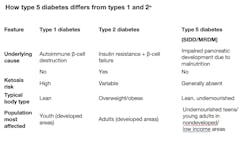Type 5 diabetes (severe insulin-deficient diabetes): What every dental professional should know
What you'll learn in this article
- How to distinguish type 5 diabetes (T5DM) from types 1 and 2, with emphasis on its link to malnutrition and absence of ketosis.
- Key oral signs—xerostomia, periodontal disease, mucosal lesions, and delayed healing—that may prompt early recognition in the dental setting.
- Why misdiagnosis and inappropriate insulin dosing are dangerous, and how dental teams can support accurate referral and nutritional guidance.
Introduction
As dental professionals, we are often the first health-care providers to note systemic signs of diseases like diabetes—particularly when patients present with oral manifestations such as delayed wound healing, xerostomia, or periodontal disease. With type 5 diabetes, a newly recognized form of diabetes distinct from types 1 and 2, understanding its unique characteristics is more important than ever. Officially classified in April 2025 by the International Diabetes Federation (IDF), type 5 diabetes (T5DM)—also known as severe insulin‑deficient diabetes (SIDD) or malnutrition‑related diabetes mellitus (MRDM)—affects lean, malnourished individuals, most commonly in low‑ and middle‑income countries.1
Unlike types 1 and 2 diabetes, T5DM is neither autoimmune-mediated nor primarily driven by insulin resistance. Instead, it results from impaired pancreatic development and disrupted insulin signaling pathways due to prolonged nutritional deficiencies.2 T5DM results from chronic malnutrition, particularly during childhood or adolescence, which impairs pancreatic development and drastically reduces insulin production. This distinguishes it from:
- Type 1 diabetes, which is autoimmune, involving destruction of pancreatic β‑cells
- Type 2 diabetes, characterized by insulin resistance, often linked to obesity
Type 5 diabetes is nonautoimmune, not insulin-resistant, and typically does not involve ketosis.
Affected population: predominantly lean, undernourished adolescents and young adults in regions of Asia, Africa, and other low-income areas with an estimated 20–25 million individuals affected globally.
Key clinical features3
- Etiology: Chronic nutritional deficiency impairs pancreatic formation and function, leading to insulin deficiency (not due to autoimmunity or insulin resistance)
- Metabolic profile: Insulin-deficient but not insulin-resistant; contrary to type 1, ketosis and ketonuria are generally absent
- Symptoms: Polyuria (frequent urination), polydipsia (excessive thirst), unexplained weight loss, fatigue, blurred vision; frequently diagnosed in patients with BMI <19 kg/m²
Treatment and management5
Managing T5DM requires a context‑specific, nuanced approach:
- Insulin therapy: When used, it must be at very low doses, as standard insulin regimens can lead to severe hypoglycemia—or even death.
- Oral medications: Agents that enhance insulin secretion may be effective, particularly in resource‑limited settings.
- Nutritional support: Central to care—patients benefit from a high‑protein, low‑carbohydrate diet accompanied by micronutrient correction.
- Combination therapy: Often a tailored plan combining nutritional intervention, oral agents, and minimal insulin dosing works best.
Why dentists must recognize type 5 diabetes
- Oral manifestations signal systemic disease
T5DM may present with periodontal disease, xerostomia, mucosal lesions, and poor healing, much like other types, yet misdiagnosis or delayed diagnosis can obscure these clues. - Misdiagnosis leads to harm
Without recognition of T5DM, patients are often misclassified as type 1 or 2. High-dose insulin therapy can be dangerous in type 5, leading to adverse outcomes. - Global equity in care
Since type 5 mainly affects individuals in low-income and underserved communities, dental professionals—particularly those serving vulnerable populations—play a vital role in early detection and appropriate referral. - Integrating nutrition, systemic, and oral health
Dental care can support nutritional counseling, provide referrals for endocrinology and dietetics, and reinforce the importance of protein-rich diets and oral hygiene in improving both metabolic and dental outcomes. - New guidelines and education on the horizon
The IDF’s Type 5 Diabetes Working Group was launched in April 2025 to develop diagnostic criteria, treatment guidelines, a global registry, and educational modules for health-care professionals. It documents the condition’s characteristics—low insulin secretion, low hepatic and visceral fat, enhanced glucose uptake, and reduced endogenous glucose production—and underscores the potentially fatal risk of misdiagnosis, emphasizing the need for low‑dose insulin, oral agents, and nutritional support.
Conclusion: Why this matters to dental professionals
As dentists and oral health-care providers, we are strategically positioned to observe signs that might indicate systemic diseases such as type 5 diabetes—particularly in underweight or malnourished individuals presenting with oral health issues. Recognizing the distinct nature of T5DM—and its severe insulin deficiency rooted in malnutrition—empowers us to:
- Avoid inadvertently dangerous referrals or recommendations (e.g., standard insulin protocols)
- Collaborate with medical colleagues to ensure appropriate diagnostic evaluation
- Advocate for patients in limited-resource settings who are disproportionately affected
- Stay ahead of evolving clinical guidelines as the IDF Working Group develops them
The formal recognition of type 5 diabetes in April 2025 marks a turning point. As dental professionals, integrating this understanding into our practice reinforces our role in holistic, equitable health care—and ensures that malnutrition-linked diabetes no longer goes unrecognized in the dental chair.
Download the type 5 diabetes dental checklist
Download the type 5 diabetes patient flyer
Editor’s note: This article originally appeared in Perio-Implant Advisory, a chairside resource for dentists and hygienists that focuses on periodontal- and implant-related issues. Read more articles and subscribe to the newsletter.
References
- IDF launches new type 5 diabetes working group. International Diabetes Federation. April 15, 2025. https://idf.org/news/new-type-5-diabetes-working-group/
- Prajitno JH, Sutanto H. Type 5 diabetes as a growing malnutrition driven health crisis in low and middle income countries. J Diabetes Metab Disord. 2025;24(2):162. doi:10.1007/s40200-025-01674-w
- Thomassian B. Type 5 diabetes – formally recognized. Diabetes Education Services. https://diabetesed.net/type-5-diabetes/
- Jebasingh F, Thomas N. Type 5 diabetes – the rejuvenated spirit from a ghost of the past. Indian J Endocrinol Metab. 2025;29(3):249-252. doi:10.4103/ijem.ijem_404_25
- Selim S. Type 5 diabetes mellitus: global recognition of a previously overlooked subtype. Bangladesh J of Endocrinol Metab. 2025;4(2):59-60. doi:4103/bjem.bjem_13_25
About the Author

Scott Froum, DDS
Editorial Director
Scott Froum, DDS, a graduate of the State University of New York, Stony Brook School of Dental Medicine, is a periodontist in private practice at 1110 2nd Avenue, Suite 305, New York City, New York. He is the editorial director of Perio-Implant Advisory and serves on the editorial advisory board of Dental Economics. Dr. Froum, a diplomate of both the American Academy of Periodontology and the American Academy of Osseointegration, is a volunteer professor in the postgraduate periodontal program at SUNY Stony Brook School of Dental Medicine. He is a PhD candidate in the field of functional and integrative nutrition. Contact him through his website at drscottfroum.com or (212) 751-8530.

